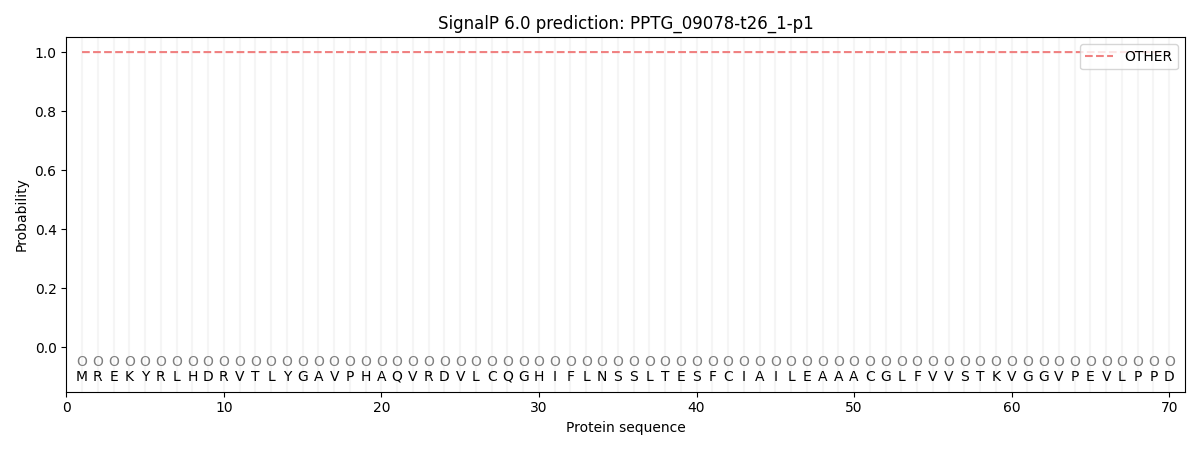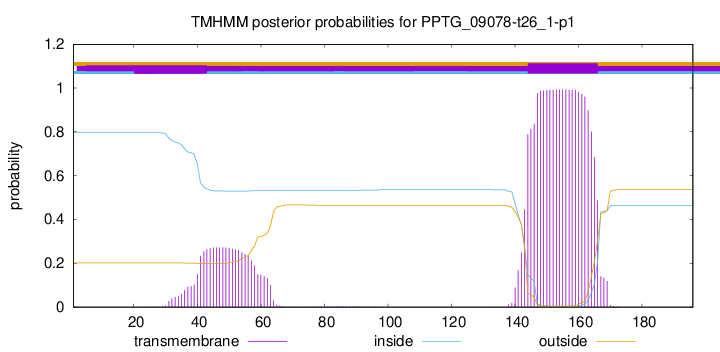You are browsing environment: FUNGIDB
CAZyme Information: PPTG_09078-t26_1-p1
You are here: Home > Sequence: PPTG_09078-t26_1-p1
Basic Information |
Genomic context |
Full Sequence |
Enzyme annotations |
CAZy signature domains |
CDD domains |
CAZyme hits |
PDB hits |
Swiss-Prot hits |
SignalP and Lipop annotations |
TMHMM annotations
Basic Information help
| Species | Phytophthora parasitica | |||||||||||
|---|---|---|---|---|---|---|---|---|---|---|---|---|
| Lineage | Oomycota; NA; ; Peronosporaceae; Phytophthora; Phytophthora parasitica | |||||||||||
| CAZyme ID | PPTG_09078-t26_1-p1 | |||||||||||
| CAZy Family | GH28 | |||||||||||
| CAZyme Description | hypothetical protein | |||||||||||
| CAZyme Property |
|
|||||||||||
| Genome Property |
|
|||||||||||
| Gene Location | ||||||||||||
Enzyme Prediction help
| EC | 2.4.1.198:26 |
|---|
CDD Domains download full data without filtering help
| Cdd ID | Domain | E-Value | qStart | qEnd | sStart | sEnd | Domain Description |
|---|---|---|---|---|---|---|---|
| 340827 | GT4_PIG-A-like | 1.59e-69 | 1 | 156 | 242 | 398 | phosphatidylinositol N-acetylglucosaminyltransferase subunit A and similar proteins. This family is most closely related to the GT4 family of glycosyltransferases. Phosphatidylinositol glycan-class A (PIG-A), an X-linked gene in humans, is necessary for the synthesis of N-acetylglucosaminyl-phosphatidylinositol, a very early intermediate in glycosyl phosphatidylinositol (GPI)-anchor biosynthesis. The GPI-anchor is an important cellular structure that facilitates the attachment of many proteins to cell surfaces. Somatic mutations in PIG-A have been associated with Paroxysmal Nocturnal Hemoglobinuria (PNH), an acquired hematological disorder. |
| 223515 | RfaB | 2.04e-18 | 1 | 128 | 249 | 379 | Glycosyltransferase involved in cell wall bisynthesis [Cell wall/membrane/envelope biogenesis]. |
| 340831 | GT4_PimA-like | 8.22e-18 | 2 | 124 | 241 | 366 | phosphatidyl-myo-inositol mannosyltransferase. This family is most closely related to the GT4 family of glycosyltransferases and named after PimA in Propionibacterium freudenreichii, which is involved in the biosynthesis of phosphatidyl-myo-inositol mannosides (PIM) which are early precursors in the biosynthesis of lipomannans (LM) and lipoarabinomannans (LAM), and catalyzes the addition of a mannosyl residue from GDP-D-mannose (GDP-Man) to the position 2 of the carrier lipid phosphatidyl-myo-inositol (PI) to generate a phosphatidyl-myo-inositol bearing an alpha-1,2-linked mannose residue (PIM1). Glycosyltransferases catalyze the transfer of sugar moieties from activated donor molecules to specific acceptor molecules, forming glycosidic bonds. The acceptor molecule can be a lipid, a protein, a heterocyclic compound, or another carbohydrate residue. This group of glycosyltransferases is most closely related to the previously defined glycosyltransferase family 1 (GT1). The members of this family may transfer UDP, ADP, GDP, or CMP linked sugars. The diverse enzymatic activities among members of this family reflect a wide range of biological functions. The protein structure available for this family has the GTB topology, one of the two protein topologies observed for nucleotide-sugar-dependent glycosyltransferases. GTB proteins have distinct N- and C- terminal domains each containing a typical Rossmann fold. The two domains have high structural homology despite minimal sequence homology. The large cleft that separates the two domains includes the catalytic center and permits a high degree of flexibility. The members of this family are found mainly in certain bacteria and archaea. |
| 404563 | Glyco_trans_1_4 | 8.53e-15 | 7 | 78 | 54 | 132 | Glycosyl transferases group 1. |
| 340828 | GT4_WlbH-like | 2.40e-14 | 1 | 126 | 249 | 376 | Bordetella parapertussis WlbH and similar proteins. This family is most closely related to the GT4 family of glycosyltransferases. Staphylococcus aureus CapJ may be involved in capsule polysaccharide biosynthesis. WlbH in Bordetella parapertussis has been shown to be required for the biosynthesis of a trisaccharide that, when attached to the B. pertussis lipopolysaccharide (LPS) core (band B), generates band A LPS. |
CAZyme Hits help
| Hit ID | E-Value | Query Start | Query End | Hit Start | Hit End |
|---|---|---|---|---|---|
| 7.64e-114 | 1 | 189 | 107 | 295 | |
| 2.86e-85 | 1 | 181 | 282 | 462 | |
| 2.86e-85 | 1 | 181 | 282 | 462 | |
| 1.55e-55 | 1 | 180 | 259 | 437 | |
| 1.96e-55 | 1 | 180 | 259 | 437 |
PDB Hits download full data without filtering help
| Hit ID | E-Value | Query Start | Query End | Hit Start | Hit End | Description |
|---|---|---|---|---|---|---|
| 5.41e-11 | 3 | 157 | 298 | 455 | Sucrose-phosphate synthase (tll1590) from Thermosynechococcus elongatus [Thermosynechococcus vestitus],6KIH_B Sucrose-phosphate synthase (tll1590) from Thermosynechococcus elongatus [Thermosynechococcus vestitus],6KIH_C Sucrose-phosphate synthase (tll1590) from Thermosynechococcus elongatus [Thermosynechococcus vestitus],6KIH_D Sucrose-phosphate synthase (tll1590) from Thermosynechococcus elongatus [Thermosynechococcus vestitus],6KIH_E Sucrose-phosphate synthase (tll1590) from Thermosynechococcus elongatus [Thermosynechococcus vestitus],6KIH_F Sucrose-phosphate synthase (tll1590) from Thermosynechococcus elongatus [Thermosynechococcus vestitus],6KIH_G Sucrose-phosphate synthase (tll1590) from Thermosynechococcus elongatus [Thermosynechococcus vestitus],6KIH_H Sucrose-phosphate synthase (tll1590) from Thermosynechococcus elongatus [Thermosynechococcus vestitus],6KIH_I Sucrose-phosphate synthase (tll1590) from Thermosynechococcus elongatus [Thermosynechococcus vestitus],6KIH_J Sucrose-phosphate synthase (tll1590) from Thermosynechococcus elongatus [Thermosynechococcus vestitus],6KIH_K Sucrose-phosphate synthase (tll1590) from Thermosynechococcus elongatus [Thermosynechococcus vestitus],6KIH_L Sucrose-phosphate synthase (tll1590) from Thermosynechococcus elongatus [Thermosynechococcus vestitus] |
|
| 1.34e-07 | 17 | 128 | 281 | 401 | Structure of Mycobacterium smegmatis alpha-maltose-1-phosphate synthase GlgM [Mycolicibacterium smegmatis MC2 155],6TVP_B Structure of Mycobacterium smegmatis alpha-maltose-1-phosphate synthase GlgM [Mycolicibacterium smegmatis MC2 155] |
Swiss-Prot Hits download full data without filtering help
| Hit ID | E-Value | Query Start | Query End | Hit Start | Hit End | Description |
|---|---|---|---|---|---|---|
| 2.51e-49 | 1 | 180 | 239 | 419 | Phosphatidylinositol N-acetylglucosaminyltransferase gpi3 subunit OS=Schizosaccharomyces pombe (strain 972 / ATCC 24843) OX=284812 GN=gpi3 PE=3 SV=1 |
|
| 3.16e-48 | 1 | 180 | 249 | 427 | Phosphatidylinositol N-acetylglucosaminyltransferase subunit A OS=Arabidopsis thaliana OX=3702 GN=PIGA PE=2 SV=1 |
|
| 5.94e-42 | 1 | 196 | 275 | 477 | Phosphatidylinositol N-acetylglucosaminyltransferase subunit A OS=Mus musculus OX=10090 GN=Piga PE=2 SV=1 |
|
| 4.32e-41 | 1 | 182 | 274 | 458 | Phosphatidylinositol N-acetylglucosaminyltransferase subunit A OS=Homo sapiens OX=9606 GN=PIGA PE=1 SV=1 |
|
| 3.18e-34 | 1 | 181 | 251 | 437 | Phosphatidylinositol N-acetylglucosaminyltransferase GPI3 subunit OS=Saccharomyces cerevisiae (strain ATCC 204508 / S288c) OX=559292 GN=SPT14 PE=1 SV=4 |
SignalP and Lipop Annotations help
This protein is predicted as OTHER

| Other | SP_Sec_SPI | CS Position |
|---|---|---|
| 1.000048 | 0.000000 |

